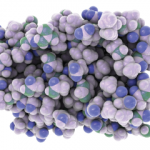If eGFR declines after starting voclosporin, it may be hard to determine if the decline is drug-related or due to worsening lupus nephritis itself. In this case, Dr. Curtis said, “I think the timing is helpful here. If the decline is related to the drug’s mechanism of action, the decline should be early—in the first month or two. So bring people back and remeasure blood pressure and eGFR. As long as there aren’t big changes, I would be reassured.”
Nintedanib & Tocilizumab for SSc-ILD
Next, Dr. Curtis turned our attention to nintedanib and tocilizumab for SSc-ILD, both of which have been approved for slowing the rate of decline in pulmonary function in adult patients with SSc-ILD.
“The annual rate of decline in forced vital capacity [FVC] as a percent was 1.4% in the nintedanib group and 2.6% in placebo,” he said. “You might think these [findings] are pretty tiny changes over the course of the year, but multiplied by 10 years [the changes are] more impressive.”
As for tocilizumab, the primary trial end point for improvement in skin fibrosis was not met. However, secondary end point data for FVC indicated that tocilizumab may preserve lung function in this population, prompting a follow-up trial that demonstrated FVC percent predicted was preserved with tocilizumab over 48 weeks.3,4
Dr. Curtis pointed out an interesting difference in the comparator arms of these two trials, acknowledging that “it’s hard to compare trials [in an] apples to apples [fashion].” In both trials, he said, the shapes of the lung function curves were similar in terms of percent predicted change from baseline FVC on either drug. However, in the tocilizumab trial, the placebo group had a more appreciable decrease of 5–6%, as opposed to the 2.6% seen in the nintedanib trial placebo group.
‘As you may be aware, nr-axSpA was a controversial diagnosis, and whether the FDA would even accept this [disease] as a real thing was a concern. It’s great to have more options.’
—Dr. Curtis
Dr. Curtis thought this [finding] was related to the populations studied in each trial, who were different. “[In the tocilizumab trial], these were people with earlier disease that was more aggressive and progressing more quickly,” he said. “They were recruited on the basis of skin disease, but we’ve known for a while that more progressive skin and lung disease are related. The drug clearly preserved lung function, even in patients who didn’t have SSc-ILD—although the impact was more profound in those who did. The point is that if your patient has early, rapidly progressive SSc, interleukin [IL] 6 therapy may be a very promising approach to help preserve lung function.”


